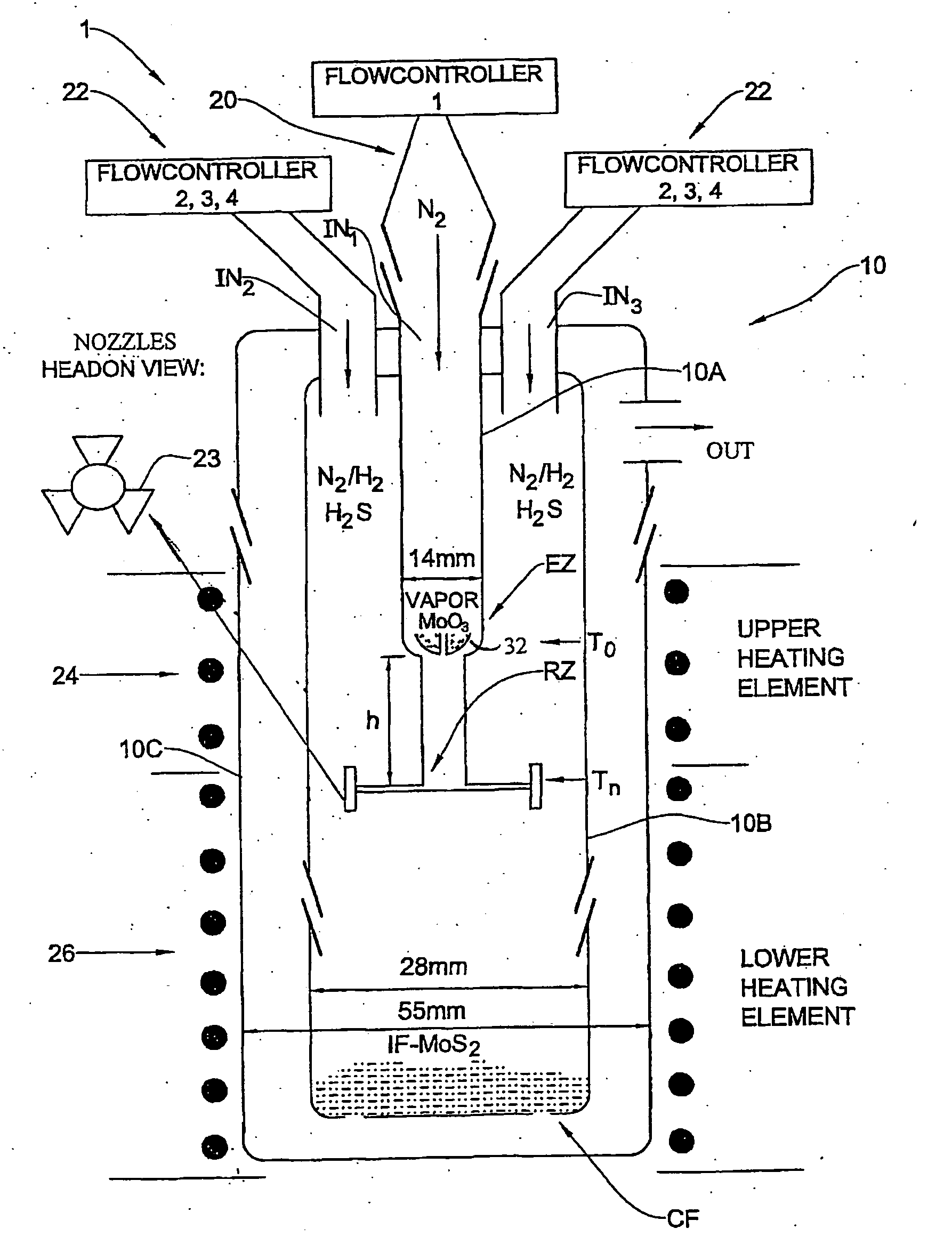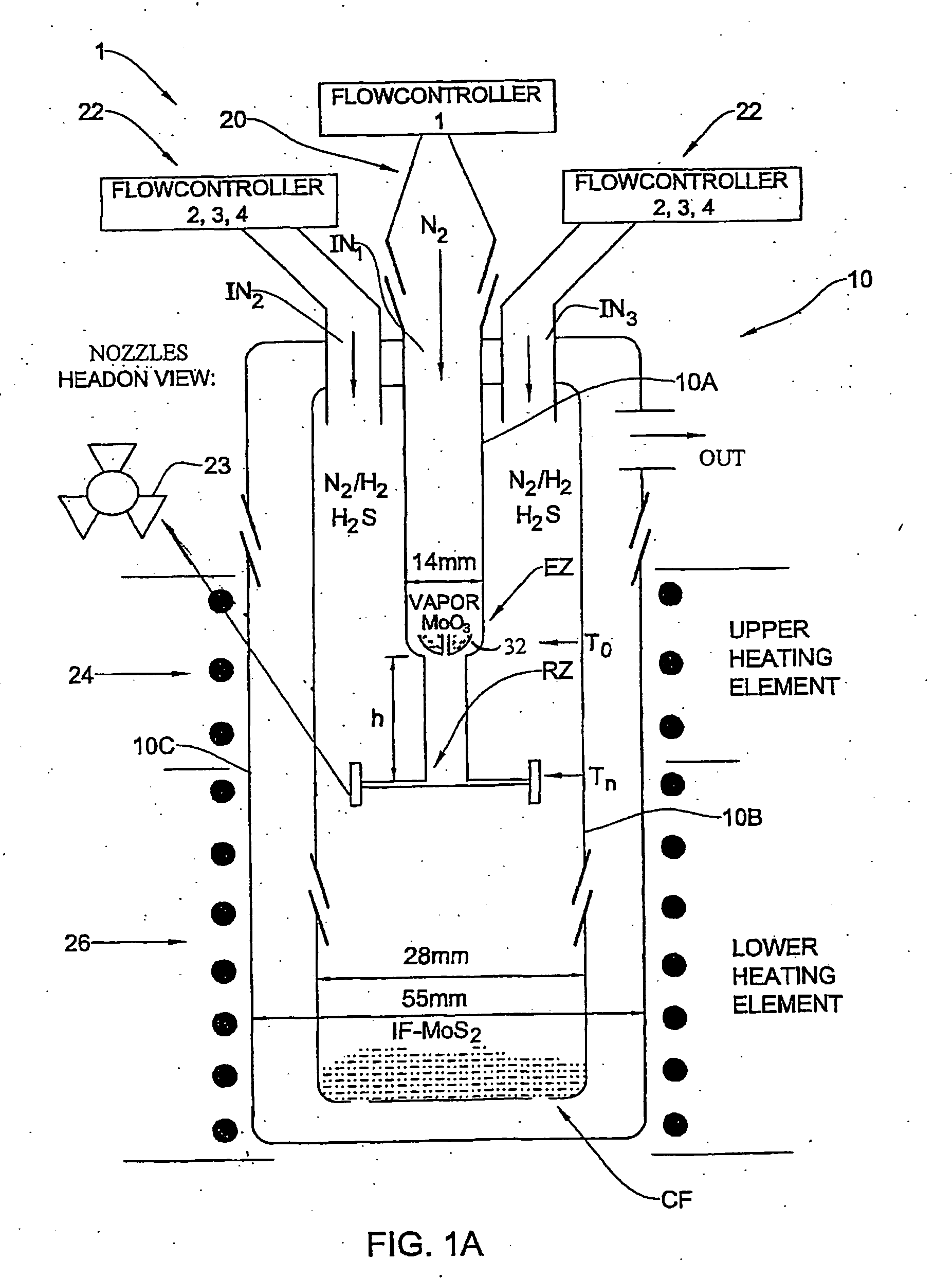Method and apparatus for producing inorganic fullerene-like nanoparticles
a fullerene-like nanoparticle, chemical method technology, applied in chemical/physical/physical-chemical processes, selenium/tellurium compunds, cell components, etc., can solve the problems of limited size control and small amount of nanoparticles, and achieve the effect of facilitating the production of inorganic fullerene-like nanostructures
- Summary
- Abstract
- Description
- Claims
- Application Information
AI Technical Summary
Problems solved by technology
Method used
Image
Examples
example 1
[0093] In the present example, typically 1 g of MoO3 powder was placed in the bucket 32 where the amount of the evaporated powder in each experiment is in the range of 100-150 mg. Such a portion does not influence appreciably the level of the oxide in the bucket. Therefore, the rate of the oxide evaporation from the bucket was time-independent. For a long experiment (that lasts more than 4 hours), the temperature T0 of the bucket 32 as to be increased during the experiment in order to keep the evaporation rate constant.
[0094] The flow rate of N2 (JN2) in the inner tube 10a (i.e., to drive the evaporated metal oxide towards the reacting zone) was controlled by the flow controller 20 (FIG. 1A). The flow of the other gases (H2S, forming gas H2 / N2 and N2) needed for the reactions to occur in the reacting zone RZ were provided by the flow controllers 22. The forming gas was supplied with different flow rates JFG and volume percents CH2 of hydrogen (CH2 =1÷8). The H2S concentration (CH2S...
example 2
[0154] Reference is made to FIG. 10A illustrating apparatus, generally designate 2, used for production of IF-MoS2 nanostructures. In the apparatus 2, a chemical reactor 50 is differs from reactor 10 of the previously described reactor 1 in several structural elements. The nozzles present in reactor 1 were eliminated. This was done since the nozzles clogged after several hours of reaction. Their elimination permits a longer reaction time resulting in higher yields. However, their elimination requires different control means on the diffusion process. For such a control, reactor 50 comprises two additional features, an additional tube 50A and filter 55 (vide infra). Thus, the chemical reactor 50 consists of three concentric quartz tubes: spaced-apart internal tubes 50A and 50B (of, respectively, narrower and higher diameters in the present example), and an external tube 50C.
[0155] The reactor 50 presents a vertical flow line defining an evaporation zone EZ and a reacting zone RZ. The...
example 3
[0162]FIG. 11 illustrates an apparatus 3 used for production of IF-MoS2 nanostructures. The apparatus 3 comprises a chemical reactor 70 that consists of three concentric quartz tubes 70A, 70B and 70C. The arrangement is such that the interior of tubes 70B and 70C are connected to each other, thereby defining inner tubes 70A and 70B, and external tube 70C. This arrangement is located inside a tube-like housing 70D. The reactor 70 presents a vertical flow line defining a reacting zone RZ starting inside the inner tube 70A at its distal end and extending into tube 70B. The resulting product is collected (precipitates) on a ceramic filter 74 located at the bottom part of the tube 70B. MoO3 powder is maintained in the tube 70A being located within an evaporation zone EZ on an additional filter 73. The reactor 70 is associated with vessels (not shown) containing, respectively, N2 (constituting an inert carrier), H2 / N2 (forming gas-constituting a first reacting agent) and H2S (constituting...
PUM
| Property | Measurement | Unit |
|---|---|---|
| temperature | aaaaa | aaaaa |
| size | aaaaa | aaaaa |
| temperature | aaaaa | aaaaa |
Abstract
Description
Claims
Application Information
 Login to View More
Login to View More - R&D
- Intellectual Property
- Life Sciences
- Materials
- Tech Scout
- Unparalleled Data Quality
- Higher Quality Content
- 60% Fewer Hallucinations
Browse by: Latest US Patents, China's latest patents, Technical Efficacy Thesaurus, Application Domain, Technology Topic, Popular Technical Reports.
© 2025 PatSnap. All rights reserved.Legal|Privacy policy|Modern Slavery Act Transparency Statement|Sitemap|About US| Contact US: help@patsnap.com



